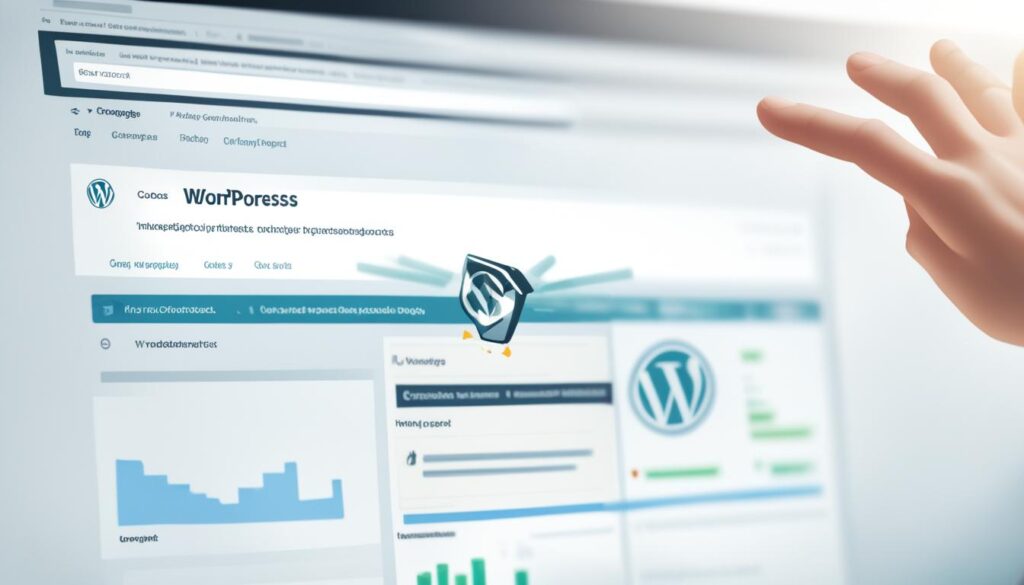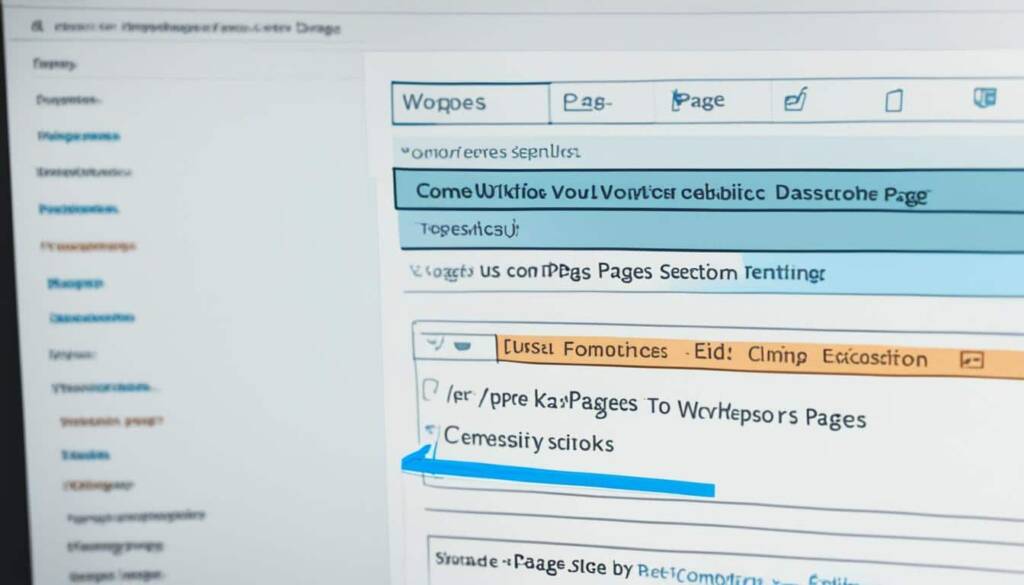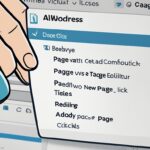Table of Contents
Welcome to the quick guide on how to edit a WordPress page! As a website owner, it’s essential to have the flexibility to update and customize your site’s content to meet your audience’s needs. With WordPress, editing your pages is a breeze, allowing you to tailor your content and enhance user engagement. In this guide, we’ll walk you through the essential steps and techniques to edit your WordPress page seamlessly.
Key Takeaways:
- WordPress provides a user-friendly platform to edit your website pages effortlessly.
- Familiarize yourself with the WordPress dashboard to easily navigate and make changes.
- Access the page editor to modify the content of your WordPress page with ease.
- Properly structure your page using headings and paragraphs for improved readability.
- Optimize SEO elements such as meta titles and descriptions to boost your page’s visibility.
Understanding the WordPress Dashboard
Before editing a WordPress page, it’s crucial to familiarize yourself with the WordPress dashboard. This section will walk you through the different components and features of the dashboard, enabling you to navigate and make changes efficiently.
When you log in to your WordPress website, you’ll be directed to the dashboard, which is the control center for managing your site’s content, appearance, and functionality.
The WordPress dashboard provides a user-friendly interface that allows you to access various settings and tools.
Components of the WordPress Dashboard
Let’s take a closer look at the key components of the WordPress dashboard:
- Admin Toolbar: Located at the top of the screen, the admin toolbar provides quick access to essential features, such as adding a new post, editing your profile, or viewing your site.
- Dashboard Menu: The dashboard menu is situated on the left-hand side and consists of various menu options, including:
- Dashboard: Displays an overview of your site’s activity, such as recent comments and published posts.
- Posts: Allows you to manage and create new blog posts.
- Media: Provides access to your site’s media library for uploading and managing images, videos, and other files.
- Pages: Allows you to create and manage individual pages on your website.
- Appearance: Contains options for customizing your site’s theme, menus, and widgets.
- Plugins: Lets you install, activate, and manage plugins to enhance your site’s functionality.
- Users: Enables you to manage user accounts, roles, and permissions.
- Settings: Contains various settings for configuring your site, including general, writing, reading, and permalinks settings.
- Widgets: Located on the right-hand side of the dashboard, widgets provide a quick overview of useful information, such as recent drafts, site activity, or a calendar.
- Quick Draft: This section allows you to create a new blog post draft directly from the dashboard without navigating to the posts menu.
- Activity: The activity section provides real-time updates on comments and updates from other WordPress sites you are linked to.
With a solid understanding of the components and features of the WordPress dashboard, you’ll be well-equipped to navigate and manage your website effectively. Take some time to explore the various menu options and experiment with different settings to customize your WordPress experience.
| Name | Description |
|---|---|
| Admin Toolbar | Located at the top of the screen, provides quick access to essential features. |
| Dashboard Menu | Located on the left-hand side, contains various menu options for managing different aspects of your website. |
| Widgets | Located on the right-hand side, provides a quick overview of useful information. |
| Quick Draft | Allows you to create a new blog post draft directly from the dashboard. |
| Activity | Provides real-time updates on comments and updates from other WordPress sites. |
Accessing the Page Editor
Once you’ve grasped the WordPress dashboard, it’s time to learn how to access the page editor. The page editor is where you can make all your desired edits to customize your WordPress page. Follow the step-by-step guide below to easily access the page editor:
- Login to your WordPress dashboard.
- On the left-hand side menu, locate and click on the “Pages” option. This will open the Pages screen, displaying a list of all the pages on your WordPress site.
- Select the page you want to edit by clicking on its title. This will take you to the specific page editor for that page.
- You are now in the page editor, where you can modify the content, add or remove elements, and make any necessary changes to suit your needs.
Accessing the page editor is a straightforward process that allows you to have full control over the content and design of your WordPress page. With this easy access, you can efficiently update your site’s information, ensuring it stays relevant and engaging for your audience.

Now that you know how to access the page editor, let’s move on to the next section, where we will delve into modifying the content of your WordPress page.
Modifying Page Content
Once you have the page editor open, you can easily modify the content of your WordPress page. Whether you want to add new text, delete existing content, or edit images and videos, this section will guide you through the process.
Adding Text
1. To add text to your page, simply place the cursor in the desired location within the editor.
2. Begin typing the new text, and it will appear on the page instantly.
Deleting Text
1. To delete text, select the portion you want to remove by clicking and dragging the cursor over it.
2. Press the delete or backspace key on your keyboard to remove the selected text.
Editing Images
1. To edit an image, click on it within the editor.
2. A toolbar with editing options will appear. You can resize, crop, rotate, or apply filters to the image.
Embedding Videos
1. To embed a video, place the cursor at the desired location within the editor.
2. Click on the “Add Media” button in the toolbar above the editor.
3. Upload your video file or choose one from your media library.
4. Once the video is uploaded, click on it to select it.
5. Finally, click the “Insert” button to embed the video into your page.
By following these simple steps, you can easily customize and modify the content of your WordPress page to suit your needs.
Now that you know how to modify the content of your WordPress page, you have the power to create engaging and dynamic web pages that captivate your audience. Whether it’s updating text, enhancing images, or embedding videos, take advantage of the flexibility offered by WordPress and make your page truly stand out.
Structuring your Page with Headings and Paragraphs
Properly structuring your page with headings and paragraphs is not only important for improving readability, but it also plays a crucial role in search engine optimization. When you use headings and paragraphs effectively, it helps search engines understand the hierarchy and context of your content, making it easier for them to index and rank your page.
Headings are hierarchical tags ranging from h1 to h6, with h1 being the most important and h6 being the least. These tags help organize your content into sections and sub-sections, allowing readers to scan and navigate quickly. Additionally, headings signal the topic and relevance to search engines, improving your chances of ranking higher for relevant keywords.
As you structure your WordPress page, consider the following tips:
- Use a logical hierarchy: Start with an h1 heading for the page title, followed by h2 headings for major sections, and use h3 headings for sub-sections within those sections. Keep the hierarchy consistent throughout your page.
- Keep headings concise and descriptive: Use clear and concise headings that accurately reflect the content under each section. This helps readers and search engines quickly grasp the topic and purpose of each section.
- Add relevant keywords: Incorporate SEO keywords naturally into your headings, but avoid stuffing them. Ensure that your headings accurately represent the content while also being optimized for search engines.
In addition to headings, paragraphs are essential for structuring your content effectively. Paragraphs give your text breathing space and make it easier to read. They help break down your content into manageable chunks, making it more scannable and engaging for your audience. When writing paragraphs:
- Keep paragraphs concise: Aim for 2-3 sentences per paragraph to maintain reader interest and avoid walls of text.
- Focus on one idea per paragraph: Each paragraph should have a clear topic or idea, allowing readers to easily follow your train of thought.
- Use transition words: Transition words or phrases, such as “however,” “similarly,” or “in conclusion,” help readers understand the flow and connection between paragraphs.
“Properly structuring your page with headings and paragraphs not only enhances readability, but it also improves the user experience and makes your content more SEO-friendly.”
By following these guidelines and organizing your content with well-structured headings and paragraphs, you can create a user-friendly and search engine optimized WordPress page.
Example of Heading and Paragraph Structure:
| Section | Heading | Paragraph |
|---|---|---|
| Headings | Page Title | Keep your page title as an h1 heading, representing the main topic of your page. |
| Headings | Main Section | Use h2 headings to divide your page into major sections. |
| Headings | Sub-Section | For sub-sections within the main section, use h3 headings to create a clear hierarchical structure. |
| Paragraphs | N/A | Break your content into paragraphs to improve readability and maintain a clear flow of ideas. |
Remember, proper structuring of your WordPress page with headings and paragraphs benefits both your audience and search engine visibility. Take the time to organize your content effectively, and you’ll reap the rewards in improved user experience and SEO rankings.
Optimizing SEO Elements
To enhance your WordPress page’s visibility in search engines, it’s essential to optimize SEO elements such as meta titles, meta descriptions, and keywords. When done effectively, SEO optimization can significantly improve your website’s search engine rankings and drive more organic traffic.
Meta Titles: The meta title is an HTML element that defines the title of your webpage. It appears as the clickable headline in search engine results pages (SERPs). To optimize your meta titles:
- Include relevant keywords: Incorporate targeted keywords naturally into your meta title to catch the attention of search engine crawlers.
- Keep it concise: Limit your meta title to 50-60 characters to ensure it’s displayed properly on SERPs. Make sure to provide a clear and compelling title that accurately represents the content of the page.
- Avoid duplicate titles: Each page on your website should have a unique meta title to avoid confusion for search engines and users.
Meta Descriptions: The meta description is a brief summary of your webpage’s content that appears below the meta title on SERPs. Optimizing your meta descriptions can improve click-through rates and entice users to visit your page. When optimizing meta descriptions:
- Craft engaging descriptions: Write persuasive meta descriptions that accurately summarize the page’s content and encourage users to click through.
- Include relevant keywords: Integrate targeted keywords into your meta description to help search engines understand the relevance of your page to the user’s query.
- Keep it concise: Limit your meta description to 150-160 characters to ensure it’s fully displayed on SERPs. Focus on providing a clear and compelling description that highlights the unique value of your page.
- Research relevant keywords: Use keyword research tools to identify high-volume and low-competition keywords related to your content. Incorporate these keywords naturally into your page’s headings, paragraphs, and image alt attributes.
- Focus on long-tail keywords: Long-tail keywords are more specific and targeted, allowing you to attract users who are actively searching for exactly what you offer.
- Avoid keyword stuffing: While it’s important to include keywords, avoid overusing them. Aim for a natural keyword density that doesn’t compromise the readability and quality of your content.
By optimizing these SEO elements, you can improve your WordPress page’s visibility in search engine results and attract more organic traffic to your website.
Conclusion
In conclusion, this quick guide has equipped you with the necessary knowledge to edit your WordPress page seamlessly. By employing the techniques outlined in this article, you can tailor your content to suit your specific needs, enhance user engagement, and ultimately improve the overall performance of your website.
Understanding the WordPress dashboard is crucial for efficient editing. Navigating through its various components and features enables you to make changes easily and effectively. Once you are familiar with the dashboard, accessing the page editor becomes a breeze, allowing you to modify your content effortlessly.
When modifying your page content, you can add, delete, or edit text, images, videos, and other elements to create a customized experience for your visitors. Structuring your page with proper headings and paragraphs enhances readability and helps with search engine optimization, increasing your chances of being found by your target audience.
To further optimize your WordPress page, focus on improving SEO elements such as meta titles, meta descriptions, and keywords. By implementing best practices in these areas, you can enhance your page’s visibility in search engine results and attract more organic traffic to your website.
FAQ
How do I edit a WordPress page?
To edit a WordPress page, follow these steps:
1. Log in to your WordPress dashboard.
2. Navigate to the Pages section.
3. Find the page you want to edit and click on it.
4. The page editor will open where you can make the desired changes.
5. Add or edit text, images, videos, and other elements to customize your page.
6. Once you’ve made the necessary edits, remember to save your changes.
What is the WordPress dashboard?
The WordPress dashboard is the control panel where you can manage your website’s settings, content, and functionality. It provides access to various features such as creating and editing pages, adding plugins, modifying themes, and monitoring website analytics.
How do I access the page editor in WordPress?
To access the page editor in WordPress:
1. Log in to your WordPress dashboard.
2. Go to the Pages section.
3. Find the page you want to edit and click on it.
4. The page editor will open, allowing you to make changes to the content and design of the page.
Can I modify the content of a WordPress page?
Yes, you can modify the content of a WordPress page. Once you open the page editor, you can add, delete, or edit text, images, videos, and other elements. This allows you to customize the page according to your requirements and keep the content up to date.
How do I structure my WordPress page with headings and paragraphs?
To structure your WordPress page with headings and paragraphs:
1. Use headings (H1, H2, H3, etc.) to define the main sections of your content.
2. Use subheadings to break down the content within each section.
3. Use paragraphs to separate and organize the text.
By properly structuring your page, you improve readability and make it easier for both users and search engines to understand the content.
How can I optimize SEO elements on my WordPress page?
To optimize SEO elements on your WordPress page:
1. Ensure your page has a unique and descriptive meta title that includes relevant keywords.
2. Write a compelling meta description, summarizing the content of the page and enticing users to click.
3. Use relevant keywords naturally throughout your page content.
4. Optimize images by adding alt tags that describe the image using keywords.
By following these optimization techniques, you can improve your page’s visibility in search engine rankings.












